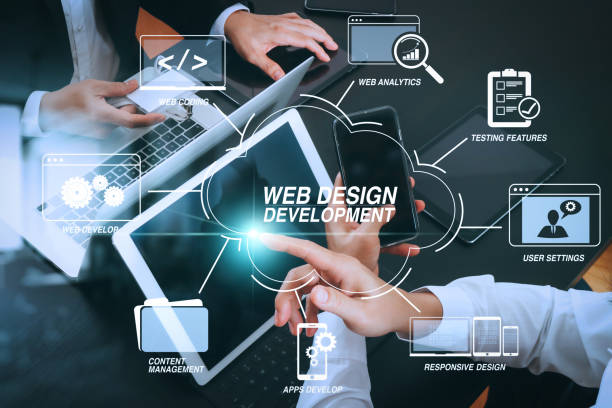Aligned Position Web Design: Crafting Visually Appealing Websites for Modern Businesses
Aligned Position Web Design: Crafting Visually Appealing Websites for Modern Businesses
Blog Article
The Very Best Sorts Of Web Design to Boost Individual Experience and Involvement
In the ever-evolving landscape of electronic communication, the performance of website design dramatically impacts individual experience and involvement. Different layout methods, such as minimal, responsive, and interactive designs, each deal distinct benefits that can deal with varied user requirements. Understanding which types of website design finest serve these objectives can be critical for organizations aiming to boost customer fulfillment and retention. The concern stays: which style elements absolutely reverberate with customers and foster purposeful involvement? The exploration of these concepts exposes crucial understandings that may redefine your technique to website design.
Minimalist Web Design
As digital landscapes come to be significantly cluttered, minimalist website design has arised as a powerful approach to enhancing customer experience. This layout approach focuses on simpleness, focusing on vital elements while eliminating unneeded disturbances. By making use of enough white room, straightforward navigation, and a restricted shade combination, minimalist design fosters clearness and guides individual attention to crucial material.
The core principle of minimalist Web style is to develop a smooth communication for users. By decreasing cognitive load, customers can promptly understand info without really feeling bewildered. This direct approach not just enhances functionality however likewise encourages involvement, as visitors are more probable to check out a website that is very easy and visually appealing to browse.
In addition, minimalist layout typically stresses typography and imagery, using these aspects purposefully to share messages efficiently. In significance, minimal Web layout is not just a fad; it is a thoughtful method that identifies the relevance of user-centered layout.
Receptive Web Style
In today's diverse digital environment, responsive Web layout has actually come to be essential for producing a smooth individual experience throughout a plethora of tools. As individuals gain access to web sites on smart devices, desktops, tablets, and laptops, the capability of an internet site to adjust its format and content to different display sizes and resolutions is vital.
Receptive Web style utilizes adaptable grids, pictures, and CSS media inquiries to guarantee that Web material exists optimally, no matter the gadget utilized. This method not only boosts the visual appeal of a website yet additionally dramatically enhances usability. Users are more probable to engage with a website that uses a regular experience, as it gets rid of the irritation of having to zoom in or scroll exceedingly.
By embracing receptive style, organizations can enhance their presence and reach a more comprehensive audience. In recap, responsive Web style is an essential technique that enhances individual experience, involvement, and overall contentment.
Interactive Website Design
Receptive website design lays the foundation for enhancing individual experience, however interactive Web design takes this a step better by engaging users in an extra dynamic method - Aligned Position Web Design. By including components such as animations, clickable prototypes, and real-time comments, interactive Web style mesmerizes customers, attracting them into a richer browsing experience
This technique not just fosters engagement but likewise motivates customers to explore content actively as opposed to passively consuming it. Methods such as gamification, where individuals gain incentives for finishing jobs, can considerably improve the time invested in a site and enhance general contentment. Furthermore, interactive features can simplify complex info, making it much more satisfying and digestible.

Integrating interactive layout elements can additionally bring about higher conversion rates, as customers are more probable to engage with a website that actively includes them. Aligned Position Web Design. Ultimately, interactive reference Web design changes customer experiences into memorable journeys, ensuring that site visitors return time after time
Flat Style
Defined by its minimalistic strategy, flat design highlights simplicity and performance, stripping away unnecessary aspects and focusing on crucial features. This style approach focuses on use, making certain that customers can navigate user interfaces easily and performance. By utilizing a clean aesthetic, flat design gets rid of the mess often found in more ornate designs, consequently improving user focus on content and capability.
The characteristic of flat layout depends on its usage of strong colors, simple typography, and geometric forms. These aspects add to an aesthetically attractive interface that is both modern-day and approachable. Additionally, level layout promotes a sense of quality, allowing customers to recognize necessary activities and information without distraction.
Moreover, flat style is Learn More Here specifically reliable in responsive Web layout, as its simplicity equates well throughout different devices and display sizes. By concentrating on important functions, level style not just fulfills user requirements yet also encourages smooth communication, making it a crucial part of efficient Web design strategies.
Adaptive Web Style
Adaptive Web layout customizes the individual experience by developing numerous fixed designs customized to different screen sizes and gadgets. Unlike responsive style, which fluidly readjusts a single design, adaptive style utilizes distinctive formats for details breakpoints, making sure optimum presentation on numerous systems. This approach allows designers to concentrate on the one-of-a-kind characteristics of each device, boosting usability by delivering specifically what users need based on their context.
Among the main benefits of adaptive Web layout is its capacity to maximize lots times and efficiency. By serving customized content and pictures that fit the individual's gadget, sites can reduce data use and boost loading rates. This is specifically advantageous for users with slower connections or minimal information plans.

Additionally, adaptive layout assists in a more constant and regulated branding experience. Because developers develop multiple designs, they can make sure that the aesthetic aspects align with the brand name's identification across different systems - Aligned Position Web Design. This results in a cohesive individual experience, improving involvement and promoting individual retention
Verdict
Finally, the integration of minimalist, receptive, and interactive website design principles substantially boosts user experience and engagement. Minimalist style promotes clearness and emphasis, while receptive design ensures adaptability throughout numerous devices, promoting ease of access. Interactive layout mesmerizes users with vibrant components, urging expedition and customization. Jointly, these design approaches add to the development of straightforward settings that not just boost satisfaction but also drive higher conversion rates, highlighting their important relevance in modern website design techniques.

Minimalist design promotes clearness and emphasis, while receptive style makes certain versatility across various devices, promoting availability. Jointly, these style approaches contribute to the development of easy to use settings that not just improve complete satisfaction but additionally drive greater conversion prices, emphasizing their critical importance in contemporary Web layout approaches.
Report this page